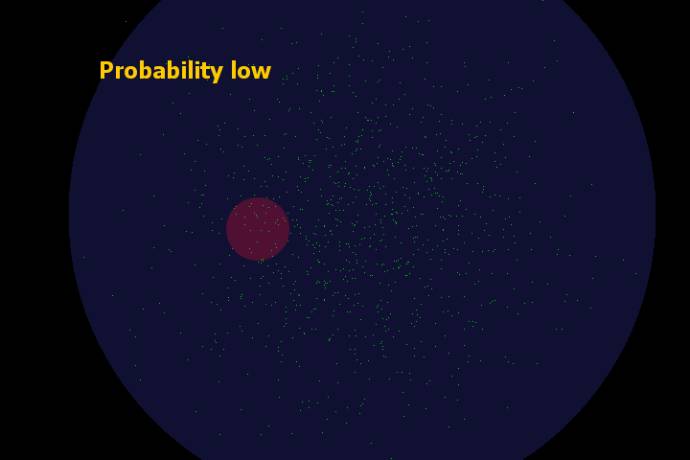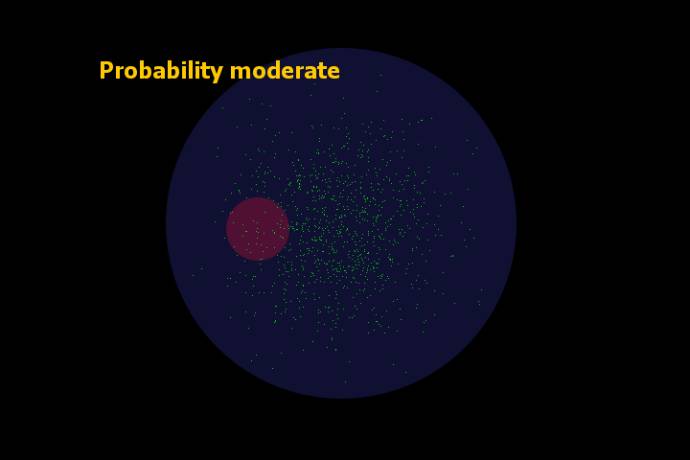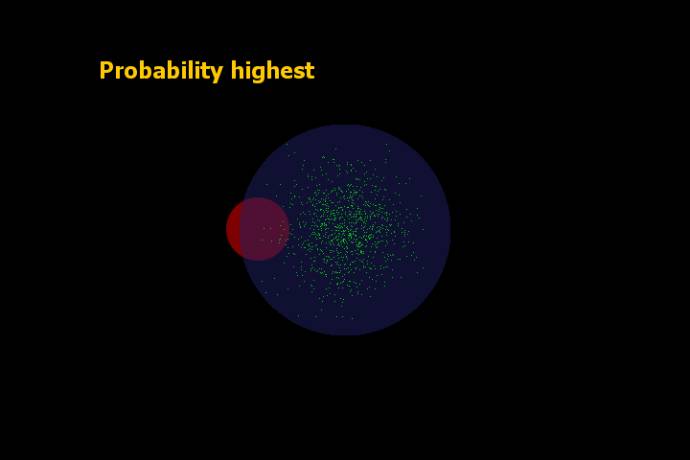|
Planetary Impacts
|
|
| SpaceEngineer | Date: Tuesday, 05.03.2013, 10:33 | Message # 31 |
 Author of Space Engine
Group: Administrators
 Russian Federation
Russian Federation
Messages: 4800
Status: Offline
| Quote (Watsisname) Does anyone know whether (with accurate treatment of orbits) the comet passes over the day or night side of Mars? Perhaps the uncertainty is still too large to narrow it down one way or the other
At night side with 99% probability. I used latest data for comet's orbit. It passes above dark hemisphere of the planet. However, collision may occur on the day side, because comet approaching to the Mars "from the flank".

|
| |
| |
| midtskogen | Date: Tuesday, 05.03.2013, 14:24 | Message # 32 |
 Star Engineer
Group: Users
 Norway
Norway
Messages: 1674
Status: Offline
| One estimate based on the latest observations gives C2013 A1 a 1/1250 chance of hitting Mars. That's pretty high.
NIL DIFFICILE VOLENTI

|
| |
| |
| HarbingerDawn | Date: Tuesday, 05.03.2013, 14:33 | Message # 33 |
 Cosmic Curator
Group: Administrators
 United States
United States
Messages: 8717
Status: Offline
| Quote (midtskogen) One estimate based on the latest observations gives C2013 A1 a 1/1250 chance of hitting Mars. That's pretty high.
Estimates always get higher before they get lower, as at first the narrowing cone of uncertainty will still contain the entire planet. Then as it narrows further only part of the planet remains, and then eventually none, which makes the probability 0 (assuming of course that the actual path misses the planet). So this is not the first time that an object generated a relatively high chance of impact.
All forum users, please read this!
My SE mods and addons
Phenom II X6 1090T 3.2 GHz, 16 GB DDR3 RAM, GTX 970 3584 MB VRAM
|
| |
| |
| midtskogen | Date: Tuesday, 05.03.2013, 15:38 | Message # 34 |
 Star Engineer
Group: Users
 Norway
Norway
Messages: 1674
Status: Offline
| Quote (HarbingerDawn) Estimates always get higher before they get lower,
If it misses, the probability will approach 0, and if it hits the probability will approach 1, but the estimates as time goes by before arrival should approach either 0 or 1 in a linear fashion deviating from that line in a random fashion, otherwise I would say that the method used to estimate is broken.
But in the beginning the errors are very big, so you can pretty much get any number. And since only those with pretty high probability get attention, what we see most often is probabilities falling. That is, we hear about the objects starting out with a 1/1000 chance going to 1/1,000,000 before being written off, but not about the objects starting out with 1/1,000,000,000 going to 1/1,000,000 before being written off.
The 1/1250 chance was decreased from 1/500. Whether the next estimate will be higher or lower remains to be seen. But it follows of course that there now is a 1249/1250 chance that the estimate will rapidly drop lower eventually.
Edit: Not linear, of course, but rather exponentially.
NIL DIFFICILE VOLENTI

Edited by midtskogen - Tuesday, 05.03.2013, 15:46 |
| |
| |
| HarbingerDawn | Date: Tuesday, 05.03.2013, 16:18 | Message # 35 |
 Cosmic Curator
Group: Administrators
 United States
United States
Messages: 8717
Status: Offline
| Quote (midtskogen) but the estimates as time goes by before arrival should approach either 0 or 1 in a linear fashion deviating from that line in a random fashion, otherwise I would say that the method used to estimate is broken.
No, this is wrong, as I explained. Let me go into more detail.
When the margin of error is large, you have a wide expanse of space in which the comet could be at some point in the future. In this case, that expanse of space encompasses the entire planet Mars and a lot of the surrounding space. Some percentage of that total space is occupied by Mars, and the ratio of those two is your probability of impact.

Now, as time goes on and the margin of error decreases, the expanse of space that the comet could possibly occupy also decreases. But, at least initially, the entire planet Mars would still be inside that space. So the ratio of total possible space that the comet could be in to the space occupied by Mars will increase, thus increasing the odds of impact.

As time goes on further, the margin of error decreases again, and the expanse of space that the comet might possibly occupy shrinks again. This will continue until until either none of Mars is inside the possible path, or only Mars is inside the possible path.
In the former case, the odds of impact will continue to increase until the outer edge of the error cone meets and starts to move through Mars. At this point the odds of impact will start to level off, then will decrease sharply until the edge of the error cone has completely moved through Mars and the risk will drop to 0.


In the latter case, the odds of impact will increase normally towards 1, as you said.


So the trend is only as you expect if the comet will actually hit. If it will miss, it will increase first, then level off and then drop sharply to zero.
All forum users, please read this!
My SE mods and addons
Phenom II X6 1090T 3.2 GHz, 16 GB DDR3 RAM, GTX 970 3584 MB VRAM
Edited by HarbingerDawn - Tuesday, 05.03.2013, 16:19 |
| |
| |
| midtskogen | Date: Tuesday, 05.03.2013, 17:24 | Message # 36 |
 Star Engineer
Group: Users
 Norway
Norway
Messages: 1674
Status: Offline
| Harb,
Yes, if the most likely centre point remains the same, you get a probability curve as you demonstrate, but the centre could also move (and will), for instance so that Mars approaches the edge and crosses out of the probability circle. Then the probability falls all the time.
Also remember that a given area in the circle doesn't represent the same probability anywhere in the circle. I.e. an area near the edge represents a smaller probability than an equally sized area in the centre.
NIL DIFFICILE VOLENTI

|
| |
| |
| HarbingerDawn | Date: Tuesday, 05.03.2013, 17:46 | Message # 37 |
 Cosmic Curator
Group: Administrators
 United States
United States
Messages: 8717
Status: Offline
| Quote (midtskogen) Yes, if the most likely centre point remains the same, you get a probability curve as you demonstrate, but the centre could also move (and will), for instance so that Mars approaches the edge and crosses out of the probability circle. Then the probability falls all the time.
Which is what I showed above.
Quote (midtskogen) Also remember that a given area in the circle doesn't represent the same probability anywhere in the circle. I.e. an area near the edge represents a smaller probability than an equally sized area in the centre.
A good point, but that would still not give a probability curve like you were originally describing.
All forum users, please read this!
My SE mods and addons
Phenom II X6 1090T 3.2 GHz, 16 GB DDR3 RAM, GTX 970 3584 MB VRAM
|
| |
| |
| midtskogen | Date: Tuesday, 05.03.2013, 20:58 | Message # 38 |
 Star Engineer
Group: Users
 Norway
Norway
Messages: 1674
Status: Offline
| Quote (HarbingerDawn) A good point, but that would still not give a probability curve like you were originally describing.
I regard statistics as one of the holes in my education, so I have to base much on intuition here, but until you back your claim with math I'll assume that you do the same.
So let's rather put your explanation to a test. The original estimation was done using the Monte Carlo method. I found some gnuplot code doing the same. Then I measured the sizes of your blue circles and I had gnuplot generate dots points for each of these sizes. I got:



Then I count the dots inside Mars:
Probability low: 32/1000
Probability moderate: 40/1000
Probability highest: 12/1000
While this doesn't prove who of us is right, it ruins your explanation.
EDIT: I don't know why the quality of the attached pictures is so bad. The original files that were sent for upload are ok. Just take my word for the dot count. 
NIL DIFFICILE VOLENTI

Edited by midtskogen - Tuesday, 05.03.2013, 21:01 |
| |
| |
| HarbingerDawn | Date: Tuesday, 05.03.2013, 21:31 | Message # 39 |
 Cosmic Curator
Group: Administrators
 United States
United States
Messages: 8717
Status: Offline
| Quote (midtskogen) While this doesn't prove who of us is right, it ruins your explanation.
It proves that I was oversimplifying, but it actually confirms what I was saying: the probability of impact goes up before it goes down, and for the same reasons that I specified.
All forum users, please read this!
My SE mods and addons
Phenom II X6 1090T 3.2 GHz, 16 GB DDR3 RAM, GTX 970 3584 MB VRAM
|
| |
| |
| midtskogen | Date: Tuesday, 05.03.2013, 22:30 | Message # 40 |
 Star Engineer
Group: Users
 Norway
Norway
Messages: 1674
Status: Offline
| Quote (HarbingerDawn) It proves that I was oversimplifying, but it actually confirms what I was saying: the probability of impact goes up before it goes down, and for the same reasons that I specified.
Then I'd like to revisit my first comment. If it barely misses a planet, it goes indeed up and down, because it barely misses. But that's a bit circular, isn't it? (strictly speaking, if you know it's going to miss, the probability is 0 all the time). Let me explain: When a new object is first seen and we only know of its existence, we don't know anything about its orbit, what is the possibility that it will hit Mars? Very small. So if it turns out that it became a near miss, of course it got up and then down again eventually to 0. But for a random new object the next observation could just as well show that it seems to be heading a different way, reducing the probability. And the next observation would confirm it and soon the probability would be 0 without any rise and fall in probability. This will be the case for most newly found objects. So for the random object, the path to 0 is pretty straight. For the extremely small subset of objects that turn out barely to miss Mars, it will go up, then down.
NIL DIFFICILE VOLENTI

|
| |
| |
| HarbingerDawn | Date: Tuesday, 05.03.2013, 22:51 | Message # 41 |
 Cosmic Curator
Group: Administrators
 United States
United States
Messages: 8717
Status: Offline
| Quote (midtskogen) For the extremely small subset of objects that turn out barely to miss Mars, it will go up, then down.
And because that is the specific case we are addressing here, the entire rest of your post is irrelevant. And even in a non-near-miss case, the same rules basically apply, just that the drop to 0 happens more quickly.
All forum users, please read this!
My SE mods and addons
Phenom II X6 1090T 3.2 GHz, 16 GB DDR3 RAM, GTX 970 3584 MB VRAM
|
| |
| |
| Watsisname | Date: Wednesday, 06.03.2013, 01:08 | Message # 42 |
 Galaxy Architect
Group: Global Moderators
 United States
United States
Messages: 2613
Status: Offline
| Another day, another debate. 
Harbinger's description of impact probability initially increasing and then decreasing rapidly to zero in cases where the object actually misses is correct -- I have seen professional astronomers talking about exactly the same phenomenon with the impact risk of Earth-approaching asteroids.
Exactly how the probability changes with time depends on the geometry of the situation and how the spatial probability distribution is treated. Honestly these finer details don't interest me, so if you all want to continue discussing it I'll just sit back and watch this time. 

|
| |
| |
| HarbingerDawn | Date: Wednesday, 06.03.2013, 01:19 | Message # 43 |
 Cosmic Curator
Group: Administrators
 United States
United States
Messages: 8717
Status: Offline
| Quote (Watsisname) Honestly these finer details don't interest me, so if you all want to continue discussing it I'll just sit back and watch this time.
I've said all I care to, anything further can be said using quotes 
All forum users, please read this!
My SE mods and addons
Phenom II X6 1090T 3.2 GHz, 16 GB DDR3 RAM, GTX 970 3584 MB VRAM
|
| |
| |
| midtskogen | Date: Wednesday, 06.03.2013, 08:23 | Message # 44 |
 Star Engineer
Group: Users
 Norway
Norway
Messages: 1674
Status: Offline
| Quote (Watsisname) Harbinger's description of impact probability initially increasing and then decreasing rapidly to zero in cases where the object actually misses is correct
Sorry, I might have a reflex of questioning it when somewhat says "always" followed by an "as" and something that cannot sufficiently explain it.
In any case, I think a 1/1250 chance, at any stage of the probability cone, is remarkable. The solar system is big and Mars is small. The first estimate was 1/500, the second 1/1250 (so it hasn't got higher, and it may or may not get higher then fall in the months to come - we'll see).Added (06.03.2013, 11:23)
---------------------------------------------
An interesting article on how seismic equipment can record impacts, even if an insignificant amount reaches the ground:
http://www.nsf.gov/news/news_summ.jsp?cntn_id=127114&org=NSF&from=news
We should get this kind of equipment to other planets as well!
NIL DIFFICILE VOLENTI

|
| |
| |
| SpaceEngineer | Date: Wednesday, 06.03.2013, 12:03 | Message # 45 |
 Author of Space Engine
Group: Administrators
 Russian Federation
Russian Federation
Messages: 4800
Status: Offline
| If this comet really so big (50 km), the impact will be catastrophic. It could not terraform Mars, but kills the life on Earth. Collision of such a mass (3.2*1016 kg, if density is 0.5 g/cm3) with a Mars at huge velocity of 56 km/s will release 5*1025 Joules of energy (= 12 millions gigatons TNT). Impact will create a crater 500 km in diameter, blow out atmosphere and cracking surface of the entire planet. Rovers will be destroyed by powerful seismic shakes of 12-13 magnitude. Explosion's fireball will be seen from Earth during many hours, with brightness compared to the full Moon. Fireball of melted rocks will flow around entire planet, heating the surface to hundreds of degrees (like a giant pyroclastic flow). Huge debris up to 1 km in diameter will be thrown into space, together with millions Chelyabinsk-like meteoroids - even Martian orbital satellites will be destroyed. Entire surface of the planet will be bombarded by debris at almost 1st cosmic velocity (3.5 km/s), and covered with few cm dust layer, increasing to few kilometers near the crater. Huge amount of dust and debris will be spreaded through the inner Solar System, absorbing sunlight and starting a global "comet winter". Some big fragments (100-1000 meters in diameter) may hit Earth, causing global catastrophe.

|
| |
| |